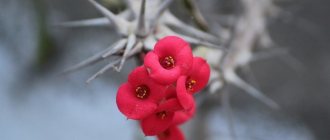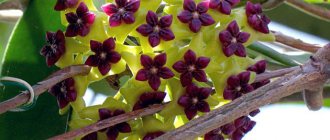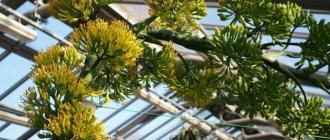Author: Elena N. https://floristics.info/ru/index.php?option=com_contact&view=contact&id=19 Category: Houseplants Published: January 20, 2019Last edits: January 11, 2021
- Dividing the bush
- Stromantha is drying
- Stromanthe amabilis
Stromanta is a plant with very beautiful leaves, a relative of arrowroot, ctenantha and calathea. The difficulty of keeping stromanta at home is that it requires high air humidity, and creating such conditions can be difficult, especially in winter, when heating devices are operating at full power. But for Stromantha admirers such difficulties are not an obstacle; they are ready to make sacrifices so that the beautiful Stromantha leaves do not lose their attractiveness.
- How to find a comfortable corner for stromanta?
- How to create optimal conditions for a plant?
- How to care for stromanta during the season of active growth and during the dormant period?
Our article answers all these questions.
Planting and caring for stromanta
- Flowering: grown as an ornamental foliage plant.
- Lighting: bright diffused light, light partial shade.
- Temperature: during the period of active growth - within 22-25 ˚C, in winter cooler conditions are needed, but the temperature should not fall below 18 ˚C.
- Watering: in the warm season - regular and plentiful, in winter - moderate to meager.
- Air humidity: very high - about 90%: daily numerous sprayings of leaves, periodic shower procedures and keeping the plant on a tray with wet pebbles are recommended. You can line the pot with moss and constantly moisten it.
- Feeding: from May to August - twice a month with complex fertilizer for decorative deciduous plants in half the dosage.
- Dormant period: not clearly expressed, but it is advisable to give the plant a rest in winter.
- Transplantation: at the end of spring using the transshipment method. Young plants are replanted annually, adults - once every 2-3 years. If you do not want to disturb the plant, simply replace the top 5 cm of substrate in the pot.
- Reproduction: by dividing the bush or by apical cuttings.
- Pests: aphids, thrips, whiteflies, mealybugs and scale insects.
- Diseases: all manifestations of ill health are associated mainly with poor care and violation of living conditions.
Read more about growing stromanta below.
plant (lat. Stromanthe) belongs to the genus of the Marantaceae family, like calathea and arrowroot itself. Various sources of information report that from five to fifteen species of Stromantha grow in nature - the problem is that it is very easy to confuse it with its related Calathea and Ctenantha, and some taxonomists do not distinguish Stromantha as a separate species at all, but classify it as a member of the genus Calathea . Stromantha is native to the tropical rainforests of South America.
Watering mode
Stromantha loves abundant watering using purified, warm, soft water. But at the same time you need to let the soil dry out a little.
In autumn and winter, it is necessary to reduce watering. Never allow the soil to dry out or become stagnant.
How to preserve and care for chrysanthemums in a pot in winterHow to take care of indoor flowers in the fall: useful tips and tricks
- How to choose a bouquet for March 8: the meaning of flowers and their quantity
Features of cultivation
The stromanthus flower is a herbaceous perennial, reaching one meter in height in nature. The main advantage of the plant is its very beautiful large leaves, up to 50 cm in length and up to 10 cm in width, painted in cream, pink, white and green colors in all sorts of combinations. The leaves are connected to the petioles by such an articulation that allows them to turn towards the light source, in whatever direction it may be.
- 5 medicines from Kalanchoe
Stromantha has the same feature as all arrowroots - its leaves fold and rise up in the evening and open, descending, in the morning. For this reason, all arrowroot plants, including stromanthus, are called praying plants.
The indoor stromanthus plant is very demanding to care for, and this often repels those who want to purchase it. Nevertheless, such a task as growing stromanthus can be easily accomplished if you understand the nature of this plant. In its natural habitat, stromantha grows along the banks of reservoirs, where the South American climate is always warm and damp, and the soils are loose and breathable. Stromanta grows in the forest at a level where direct rays of the sun almost never reach due to the closeness of the crowns of tall trees, so the plant is content with bright but diffused light. However, the duration of daylight hours in those latitudes is longer than in our climate zone.
Based on these characteristics, conditions should be created under which an indoor stromanthus flower will feel at home. The best place for small species of stromanthus is in terrariums, and for large ones you can create the necessary conditions on the windowsill.
Transfer
Flower growers recommend transferring the plant along with the earthen lump from one pot to another. Two days before transplanting, you need to water the plant and prepare the soil and pot.
If you plan to separate the roots, then it is better to dry the earthen ball a little, so it will disintegrate more easily and the seedlings can be separated without injuring the root.
Transplant stages:
- A drainage layer at least 3 cm high is poured onto the bottom of the prepared pot.
- The soil mixture for replanting is poured over the drainage.
- The plant is removed from the old pot along with the soil.
- Inspect the roots and remove dry or damaged leaves.
- Place the plant in a new pot in the center.
- Sprinkle with earth around the edges and tamp down a little.
- If the bush is tall, it is tied to a support stick.
- Next, water the plant and then take it back to its original place.
Caring for young, newly planted plants is no different from caring for adult transplanted specimens.
If the earthen lump crumbles during transplantation, the bush is covered in weight. That is, you need to hold the bush with one hand, while the lower part of the roots should slightly touch the first layer of prepared soil. Then slowly add soil and shake the pot a little. The roots should not wrinkle or lie in a lump. Gradually add soil to the desired height. At the same time, make sure that no voids form between the roots.
Caring for stromanta at home
Rules of care
Caring for a stromanta will require daily efforts from you. It is best to keep Stromantha flowers at a temperature of 22-25 ºC in the summer, and in winter the temperature should not fall below 18 ºC. Please note that stromanta at home does not tolerate drafts and temperature changes, so be careful with ventilation, eliminate all cracks in window frames and do not move the pot with the plant close to the glass in winter. The soil in the pot should also always be warm.
The lighting will need to be bright, but without direct sunlight. Stromantha is a shade-tolerant plant, but not at all shade-loving, so there must be plenty of light, otherwise the variegation of the multi-colored leaves of the stromantha will be leveled out.
Watering the stromanthus is carried out with soft, settled water at the same temperature as in the room where the plant is kept. In the warm season, the soil of Stromantha is moistened abundantly; in winter, watering is significantly reduced. Air humidity will need to be very high - about 90%. They increase the humidity by numerous daily sprayings of the leaves of the plant and keeping the stromanta on a tray with wet pebbles, expanded clay or crushed stone. You can line the pot with the plant with sphagnum, which should be moistened regularly. From time to time, give your stromante a warm shower.
- Echeveria at home: care and types
As for fertilizers, from May to August, during the period of active growth, stromantha needs to be fertilized with liquid complex fertilizer for indoor ornamental foliage plants, which should be applied in half the dose recommended by the manufacturers twice a month - stromantha is very sensitive to excess calcium in the soil and minerals, so it’s better to forget to fertilize than to do it more often or in larger doses than necessary.
Transfer
Stromantha transplantation at home is carried out at the end of spring. Young stromanthus are replanted annually, and adult plants - after 2-3 years, using the method of transferring the plant from an old pot to a new one, which makes it possible to injure the root system to a much lesser extent. If you think repotting will harm the plant, you can simply replace the top layer of soil in the pot with fresh soil. The soil for stromanta should be humus, loose, water- and air-permeable, slightly acidic (pH 6), approximately the following composition: three parts of leaf soil, one part of humus, peat and sand.
You can use a ready-made substrate for arrowroot or a Palma substrate, which are sold in flower shops. It would be good to add a little sphagnum and pieces of charcoal to the purchased or self-made soil. Before transplanting the stromanthus, it is necessary to place a layer of drainage material in the stromanthus pot approximately one quarter of its volume.
Stromantha blooming
Stromantha blooms in panicles 6-8 cm in diameter, composed of inconspicuous white flowers with red bracts on long peduncles and orange-red sepals, but at home, stromantha blooms very rarely. But if you satisfy all her whims, then maybe you will be lucky enough to see Stromantha flowers someday.
Bloom
Under natural conditions, exotic flowers bloom, producing a long peduncle, decorated with inconspicuous paniculate inflorescences of white or yellowish color. At home, stromanta does not produce color; if this happens, it is extremely rare. But, if it is suddenly noticed that it begins to produce a peduncle, it must be cut off immediately. This is the case when flowering at home acts on an indoor flower as a dangerous disease, since it leads to fading of the color, cessation of growth and falling off of the petioles.
Reproduction of stromanthus
Dividing the bush
It is most convenient to divide a stromanthus bush when replanting the plant. A large plant is divided into 2-3 parts, trying not to injure the roots. Delenki with two or three good roots and several leaves are planted in wide, shallow pots with drainage and an appropriate substrate, then the stromanthus after transplantation is placed in a warm place and tightly sealed under a transparent plastic bag until the plant takes root and produces new leaves.
Propagation by apical cuttings
Propagation of stromanthus by cuttings is also best done in late spring or summer. Apical cuttings 7-10 cm long with two or three leaves are cut from the mother plant so that the cut passes slightly below the attachment of the leaf to the shoot. The cuttings are placed in a container of water, which is covered with a transparent plastic bag to form a mini-greenhouse. The roots grow in approximately five or six weeks, after which the cuttings are planted in pots with a peat-based substrate.
Room humidity
Stromantha loves humidity up to 90%. Spray it regularly 1-2 times a day so that the climate is not dry. The water should be soft.
Place moistened moss, small pebbles or expanded clay stones in the tray, but make sure the pot is not in liquid.
To increase humidity, you can create greenhouse conditions for the flower by wrapping it in a plastic bag overnight.
Pests and diseases
Stromantha is drying
It often happens that our readers complain that the leaves of Stromanta are drying up. If the tips of the leaves of Stromantha dry out, the cause may be dry air or infection of the plant with spider mites, which is also the result of insufficient air humidity in the room. Spray the leaves of the stromanthus more frequently, keep the pebbles in the tray moist at all times, treat the leaves of the plant with a soapy solution using a sponge and do not wash off the soap for 3-4 hours, and then, after rinsing the stromanthus, place it under a plastic bag to prevent spider mites from there is still a chance to survive.
- How to grow a cattleya orchid
If you cannot defeat the tick with soap, use an “armor-piercing” treatment – Actellik. But what to do if the leaves of Stromantha dry out, and before that they also lose color? This means that Stromante does not need so much sunlight: move it to partial shade or shade it from the sun during the midday hours.
Stromantha leaves curl
Stromantha reacts to any violation of the conditions of detention by changing the state of the foliage. Why do stromantha leaves dry out? Why do they curl up and become covered in spots? Because the plant suffers from improper watering. Both in the case of excess moisture in the soil and in the case of insufficient moisture, the leaves of Stromanthus behave in a similar way - they curl and fall off. Remember: the soil of Stromanta should never dry out. But there is no need to spread liquid mud in the roots of the plant.
Stromantha leaves wither
Drooping leaves and rotting stems of stromanthus are the result of high air humidity in a room with a temperature that is not high enough for stromanthus. In this case, leave the air humidity at the same level, and try to increase the temperature in the room to 25-30 ºC.
Pests and their control
In addition to spider mites, thrips, scale insects, mealybugs and whiteflies harm Stromanthe. Whiteflies and thrips are destroyed with the same drug as spider mites - actellik. One ampoule of the drug is dissolved in a liter of water and the plant is thoroughly sprayed with this composition, then a transparent bag is put on the stromanta, which is removed after a day. If the problem cannot be solved at once, repeat the procedure in a week or two.
It is best to destroy aphids with phytoverm or inta-vir, and get rid of mealybugs in this way: dissolve one teaspoon of grated soap (any) in hot water, then add enough water to make one liter in the end, add two tablespoons of vodka, mix and Thoroughly spray the stromanta with this solution, protecting the soil in the pot from soapy water getting into it. After a day, the plant is washed from the solution, also covering the soil so that soapy water does not get into it. Treatment with a soap-vodka solution will have to be repeated every seven days two or three more times. Instead of soap, you can use any dishwashing detergent.
What does stromanta look like, what family does it belong to?
Stromanta is a flower that belongs to the arrowroot family. The closest relatives of the ornamental plant, which are also grown at home, are calathea and ctenata. Due to their similarity, stromanta and calathea are often confused.
Stromantha will bring good luck to the house
The plant in its natural environment can reach a height of up to 1 meter; in indoor conditions, the size depends on the variety and care. The oval wide leaves are half a meter long and pointed at the tips. Depending on the type, their colors can have different shades: green, lilac, white, yellow.
Flower color may vary depending on the variety
Types and varieties
In indoor culture, the most popular species have become pleasant stromantha and bloody stromantha.
Stromanthe amabilis
An ornamental deciduous plant reaching a height of 30 cm. Its leaves are long-petiolate and have a regular broad oval shape, from 10 to 20 cm in length and from 4 to 5 cm in width. On the upper side of the leaf plate there is a herringbone pattern - dark green stripes diverging in light -green background from the central vein. The underside is greyish-green with a subtle pink tint. If Stromantha pleasanta blooms, it happens in spring or summer.
Bloody stromantha, or blood-red (Stromanthe sanguinea)
Native to tropical rainforests of Brazil. It is a larger species than Stromantha pleasanta. The leaves of Stromantha bloody are oval, pointed, from 15 to 40 cm in length and from 7 to 13 in width. The top of the leaf is glossy, light green with a V-shaped dark green pattern, the underside of the leaf is a pronounced cherry hue. It blooms closer to summer with inconspicuous white flowers collected in a spike.
Of the most popular varieties of blood-red stromantha, you may like:
- stromanta multicolor - a variety in which the upper side of the leaf blade is dark green with light green and almost white streaks, and the lower side is red-burgundy;
- stromanta horticolor – the upper side of the leaf is yellow-olive-light green, the lower side is dark red;
- stromantha tricolor, or triostar, is the most popular variety form among flower growers, which has a pattern of pink, white, fawn and light green stains on the upper, dark green side of the leaf, with dark burgundy leaves on the bottom;
- variety Maroon - a light green central vein runs along the green upper side of the leaf, the underside, like all varieties of this species, is dark red;
- Stripe Star variety - along the bright green upper side of the leaf plate, right along the central vein, there is a light stripe, the underside of the leaf is burgundy.
Characteristics
- Type : decorative deciduous.
- Flower color : white/cream.
- Leaf color : variegated.
- Sun requirement : bright, diffused light.
- Size : up to 70-80 cm.
- Flowering : early summer.
- Aroma : pronounced.
Stromantha is a whimsical and difficult to care for plant. Its maintenance may be beyond the capabilities of even an experienced gardener. However, if all recommendations are carefully followed, this tropical flower will become one of the main decorations of your home for a long time.











